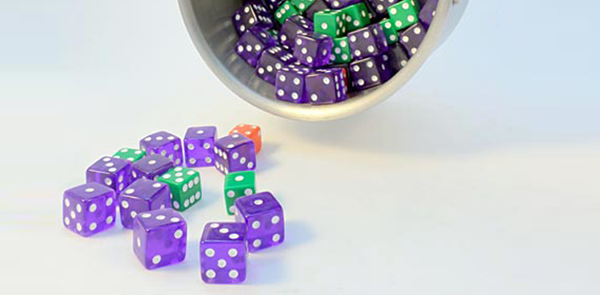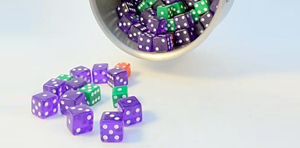Superbugs and Antibiotics: Explore with a Dice Game
Stopping the course of an antibiotic early is one way that bacteria develop greater resistance to available medicines. A new classroom activity, sponsored by Cubist Pharmaceuticals, helps students see how populations of bacteria respond to antibiotics. Using a colorful dice game, students roll the dice to see how many bacteria respond to treatment each day. How much harder is it to kill off a superbug? At the end of the game, the students can tell by looking at the dice that remain!
When a doctor prescribes an antibiotic, she probably does so with the warning that you need to make sure you take all of it&emdash;even if you start feeling better before you finish the full course of medicine. When you pick up your prescription at the pharmacy, the pharmacist might pass on the same warning—be sure and take all of the pills. When you get home, you might find that these instructions are even marked on the bottle—you need to take the pills until they are gone. Why all the warnings? Is it overkill?
What happens if you chuck the bottle of pills as soon as you are feeling better and get back into your regular routine? You may contribute to the development of even more antibiotic-resistant bacteria, that's what!
The prevalence of antibiotic-resistant bacteria, or superbugs, is a growing problem. Millions of people are infected each year with strains of bacteria that have adapted to survive the antibiotics people take. How did the bacteria get so smart? How did they morph into superbugs? How are these antibiotic-resistant bacteria flourishing?
Stopping a course of antibiotics before you finish it is one way that antibiotic-resistant bacteria continue to thrive and evolve.
Feeling Better on Day Three
The bacteria (or "bugs") that made you sick enough to seek medical attention and a prescription is one that, hopefully, the antibiotic prescribed will kill, but when you get sick, there may be millions of bacteria in your body, some of which have genetically mutated enough to be harder to kill with existing drugs. The antibiotic prescribed isn't a wonder pill. It doesn't kill all bacteria with the first dose. It doesn't necessarily kill all bacteria with the second dose. Depending on how resistant the bacteria are to the drug, some of the bacteria may be really hard to get rid of. Some may not even die off after you finish taking the medicine.
If killing bacteria is difficulty, what happens if you stop taking the pill after 5 days when 7 was prescribed)? What happens if you stop taking a 7-day antibiotic after day 3?
A new classroom activity, sponsored by Cubist Pharmaceuticals, helps students visualize how this process works by making and using a game-like model that demonstrates how a course of antibiotics affects a bacterial illness over time.
With dice of different colors representing bacteria with different levels of antibiotic resistance, students can "roll the dice" and watch to see how many bacteria are killed off each day while a patient takes a prescribed antibiotic. The activity, suitable for classroom groups or individual exploration, lets kids get hands on with superbugs in a safe and engaging way.
Making Health Connections
Pretty quickly, students will be able to see how difficult it is to kill off a superbug. But even the less resistant strains of the bacteria won't all disappear right away. Helping students visually grasp the fact that bacteria may still be lingering even though the person feels better helps increase awareness of the importance of taking all of a medication and highlights the risk superbugs pose to our health.
How many superbug dice survive the full antibiotics course in the activity? What does this mean for patient health? How many less resistant bacteria survive?
One patient stopping a course of antibiotics early may not seem like a big deal, but multiply this by hundreds of thousands of patients, and students can quickly see that the dice (or bacteria) that survive and become more and more resistant may reach frightening proportions.
Group-based STEM Activity
The Stopping "Superbugs" activity has been specially developed as an engaging in-class activity that can be done in small groups. You will need a large number of colored dice, but with materials in hand, the activity is easy to set up. Doing this important human biology experiment takes students about a half hour. Both educator and student guides are available.
To learn more about antibiotic-resistant bacteria, visit the Superbugs website.
Categories:
You Might Also Enjoy These Related Posts:
- Star Wars Projects for May the 4th Be With You Science
- Spring Science Projects: 26 Science Experiments for Spring
- 5 STEM Activities with Marshmallow Peeps
- 6 Picks for St. Patrick's Day STEM
- 12 STEM Activities for Lunar New Year - Year of the Dragon Science
- Winter Science Projects, Lessons, and STEM Activities
- Make Some New Year's Noise with Science Projects!
- Holiday STEM Projects to Make and Give











